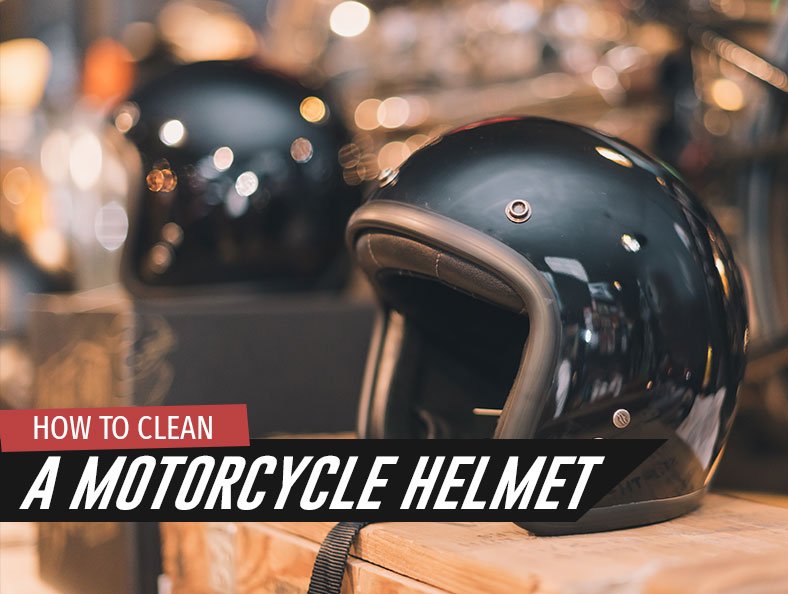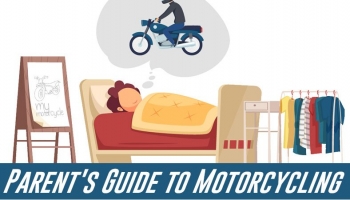How To Wash a Motorcycle Helmet – Our In-Depth Guide for 2021

Have you ever wondered when it’s time to clean your helmet? Having a quality helmet to rely on is crucial. It protects your face from different bugs and debris, but it’s also essential in case of an accident.
It’s there to protect you from the weather and provide comfort for years to come. While a high-quality model can do that without a problem, it still needs maintenance and proper care.
In the article below, we’ll teach you how to properly clean a motorcycle helmet quickly and easily. You’ll also learn some additional tips as well as why the process is as important.
Why It’s Important to Clean Properly
Think about what your helmet is exposed to every day. Sunshine, dust, debris, rain, snow, wind, and other elements affect it all the time, and that’s just on the outer shell. On the inside, the padding usually absorbs swear and oils that might produce an odor after a while.
All of this combined creates a certain funk in and outside. You might not see or feel it right away, but over time, you’ll notice it more and more. The longer you wait to clean it, the worse it will look. In the end, it might even be quite challenging to clean.
However, all of that probably won’t shorten its lifespan. Instead, what will ruin it is improper maintenance. If you scrub the shell or use an abrasive cloth, it’s most likely you’ll damage it. Most of the issues and damage are due to improper care or lack of it.
Another reason you might want to clean it is to add a layer of fresh paint. See our how-to painting guide here.
Gather the Materials
Before you get to the cleaning part, you should gather all the necessary materials. To make this part easier, we’ve made a list of what you need and why. Some of these might be considered optional, but we advise you to have them at hand for the first time.
Microfiber Cloths (Moist and Dry)
These are definitely a must for the shell as well as the face shield. It doesn’t have to be a new rag but, make sure it’s absolutely clean. Any debris and particles on the cloth might scratch or damage your helmet so rinse it as many times throughout. You’ll need at least one moist and one dry cloth.
Cotton Swabs
Cotton swabs are somewhat an optional tool. They’re quite useful when it comes to cleaning small and tight spaces. Plus, cotton is rather gentle so you can even clean parts of your face shield. Although you might not use it, we advise you to have some for just in case.

Soft-Bristled Toothbrush
You want to use a new toothbrush although it doesn’t have to be a super-quality one. Any cheap one will do as long as it has soft bristles. It’s great for around the vents as well as for crannies and nooks that you cannot reach with the cloth or cotton swabs.
Baby Shampoo or Mild Laundry Detergent
You can use either one of these as long as it’s not petroleum-based. It might be best to opt for a baby shampoo since that’s a safe option. Those products are usually quite gentle, so they won’t damage the shell surface. Mild laundry detergent will also do as long as it doesn’t have petroleum as one of the ingredients.
Warm Water
You already know that warm water cleans better than cold. It’s best when it comes to loosening the dirt and dead bugs on the surface. The only thing you should pay attention to is that it’s not too hot. Anything but warm water could harm some of the materials.
Compressed Air Can
There’s no better way of cleaning air vents than with some compressed air. Make sure you’re not using air from an aerosol can since that could erode the liner in your helmet. Such air would undoubtedly degrade all its protective abilities.
Disconnect Electronics and External Parts
You should always do this step before you proceed to clean the helmet. It might sound obvious, but this is actually something that most people overlook.
Remove all internal electronic accessories like antennas, microphones, Bluetooth communicator, speakers, batteries, and others.
Forgetting to do this might not damage the helmet, but it will most certainly ruin the electronics. Since you’ll work with wet cloths and water, those could actually go to waste unless you remove them.

Remove Interior
Although most models have a removable interior, that’s actually not always as easy to remove. Most of the padding attaches with hook-and-loop material, snaps or magnets.
If you’ve never removed it before, you should find the user manual you got with your helmet. Find all the info on how to safely remove the padding and make sure to follow it. You can only wash the liner and cheek pads properly once you get them out.
Clean Interior Pads and Liner
Remove the pads if possible and put them in a bucket of warm water. Add some baby shampoo and scrub each piece in that soapy mixture. Scrub them as long as it takes and until they feel clean. You probably know when and if you’ve cleaned these the last time so you have an idea of how dirty they might be.
Once you wash them, place them to air dry. This might take some time, so make sure to do it at least the day before you plan on riding. You want to allow enough time to dry; otherwise, they could end up smelling even worse than they did before washing.
If you have non-removable pads, you’ll have to soak the entire helmet. This takes a bit more time, but it’s really the only way to clean the interior. Use a bucket to soak the helmet before you scrub the padding. We recommend you rinse under the shower where you have a bit more space to do it with plenty of water. Again, let it air dry.
Clean Exterior
If you have non-removable pads, you probably already soaked the helmet. If not, place a moist cloth over the shell and leave it there for a while. This will soften whatever bugs, debris, and dirt that are on the surface.
Remove the cloth and use a new one to wipe the exterior. Be gentle with this step since you don’t want to damage the surface with any leftover dirt.
Remember to use only warm water and a mild detergent or baby shampoo. Other cleaning solutions, as well as hot water, could harm the materials.
Check Vents
This is where compressed air comes into play. These vents are for better, but you’ll be surprised how dirty they can get. Dust and debris get stuck in there with ease but don’t be surprised if you find a bug or other chunks as well.
All you need is a quick blast of compressed air to push all of that out in a second. We recommend you do this even if it appears that the vents are clean. They’re almost always full of fine dust at least.
Clean the Shields / Visor
Your face shield might have a protective coating such as one for UV protection or anti-fogging. For this reason, you should avoid any harsh chemicals and solutions and stick to warm water.
In most cases, you should refer to the instruction manual you got with the helmet. There you should find all the crucial info on how to clean the face shield without voiding the warranty.
If you don’t find this information, you can use a wet microfiber cloth to clean it. Remove the shield if possible and wrap it in a damp cloth, so all the crusty dirt softens. Once that’s done, massage away the dust, smudges, and dirt.
Use cotton swabs or toothbrush to clean all the grime around the shield mounting areas. Remember not to scrub too hard since that can permanently damage the surfaces.

Carefully Put Back Together
You can reassemble the helmet once everything is clean and dry. If you have removable lining and cheek pads, you can now put them back in place. Reattach the face shield and whatever other pieces you’ve removed while cleaning. Take some time with this step since everything has to be safely into place.
Additional Helpful Tips
One of the most important things to remember is to use minimal pressure and instead let warm water and baby shampoo do all the work.
Another thing you can do if you have a glossy helmet is to use an automotive polish. It’s a quick and easy way of achieving the high-gloss effect of a brand new helmet. Also, you can use some automotive wax to prevent stuff from sticking to the surface.
If you don’t have the time to wait for all the interior padding to dry, you can use a fan or a blow-dryer.
Don’t use any dryer sheets on the padding since those contain harsh chemicals. You might even have an allergic reaction to those.
If you notice any stubborn dirt on any part of your helmet, make sure to take your time with it. Pat it with a moist cloth instead of scrubbing it.
Tips Between Washing
To keep the inside fresh as long as possible, you should consider wearing a bandana or a cap. This way, you’ll protect the interior padding from body oils and sweat so you won’t have to wash it as often.
You can use some baby wipes to clean dirt and bug guts before they dry maintaining the surface clean and spotless.
Another thing that will maintain it fresh is venting. After you wear it for hours, allow it to air out for a few hours, or overnight. This way, you let the odors evaporate instead of making them worse by shoving the helmet in a bag.
Conclusion
You can probably tell that cleaning a helmet isn’t as difficult as people think. There are a few details you have to be careful with, but in general, it’s all pretty simple.
Plus, you’ll notice how every next cleaning section is easier if you try and maintain the helmet as clean and fresh as possible.
Follow our tips between washing and make sure to be patient and careful when cleaning. The better you do this, the more use you’ll get out of your helmet.






